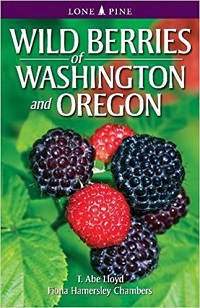
There are several books in the Miller Library collection on the wild berries and similar fruit of the native plants of the Pacific Northwest. However, none of these are recent, so it is delightful to add “Wild Berries of Washington and Oregon” to the collection, especially as it is published by Lone Pine, which has a history of publishing excellent field guides with nearly weatherproof covers, for exploring our region.
T. Abe Lloyd and Fiona Hamersley Chambers have created a practical guide to finding, foraging, and savoring the bounty of our local berries. It is a beautiful book, too, with excellent close-up photographs. If these don’t make your mouth water, the authors’ favorite recipes—and they are both experienced foragers—surely will.
This is not an ethnobotany book, although both of the authors studied with noted ethnobotanist Nancy Turner at the University of Victoria. It is not surprising that the entries in this book include the historical, Native American uses of each fruit, including the management of the prized plants that produce them. This includes more recent adaptations native peoples learned from Europeans, such as this treatment of red-osier dogwood (Cornus sericea) berries: “They were also occasionally stored for winter use, either alone or mashed with sweeter fruits such as serviceberries, and in more modern times with sugar.”
Berries are defined here in the popular sense, so included are drupes, pomes, and a few other fruits such as rose hips and juniper “berries”. Escaped and invasive berry producing plants such as the several types of introduced blackberries (Rubus species) are given equal treatment since you’ll easily find these, and most are tasty. Poisonous berries are carefully described, as are toxic parts of plants bearing edible fruit.
Excerpted from the Spring 2016 Arboretum Bulletin.